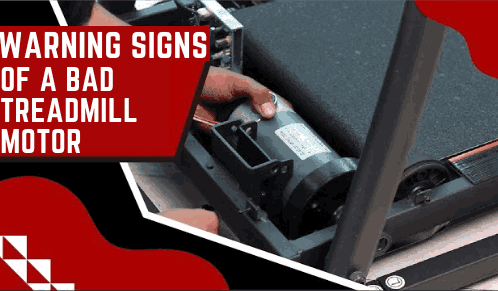How to Tell if Treadmill Motor is Bad? [Insider Information]
A treadmill can be a great way to get exercise, but if the treadmill motor is bad, it can be a huge pain. Without a treadmill motor, you’re just walking on a fancy, expensive belt. It’s like driving a car without an engine—sure, you can push it, but you’re not going to get very far. The treadmill motor is the heart of the machine, providing the power and speed to propel you forward on your fitness journey. But How to tell if treadmill motor is bad, this can be tricky.
So, in this post, we discussed some important methods for determining if your treadmill motor is faulty.
Warning Signs of a Bad Treadmill Motor

Let’s discuss about some of the clear signs of a malfunctioning treadmill motor:
1. The treadmill Won’t Turn ON
If your treadmill won’t turn on, it’s likely an issue with the motor. The motor might not be getting power, or the connections could be loose. Check the power cord and make sure that it is plugged in properly and securely. . If it is plugged in, then it could be a sign of a faulty motor.
2. Treadmill Stopping Unexpectedly
If your treadmill stops unexpectedly, it’s like your car suddenly turning off while driving down the highway. It’s not only frustrating but also dangerous (especially if you’re sprinting at top speed). This could be a sign of a malfunctioning motor or a problem with the safety switch.
3. Strange Noises Coming From The Motor
Strange noises coming from the motor may be caused by worn out plastic bushings, loose bolts and screws, a malfunctioning belt drive system or damaged bearings. One of the biggest warning signs of a bad treadmill motor is an unusual noise. A louder than normal sound when you are running or even when it is idle can be a sign that something has gone wrong with your treadmill motor.
4. Decreased Power or Treadmill Speed
Decreased power or speed of treadmills can be caused by a few things. The most common causes are worn-out motors, belt slipping, bad wiring, and electrical interference. Also, if the belt seems to be dragging or slipping while you are exercising, this can mean the motor is not providing enough power to keep it moving at the desired speed
5. Unusual Vibrations While Running
Unusual vibrations while running can be an indication of a bad motor. A malfunctioning motor can cause excessive vibrations and could damage other components of the treadmill. It is also important to inspect the belt for any signs of wear and tear, as this can be an indication of an unbalanced motor which can cause the same kind of vibration
6. Excessive Heating of Treadmill
Unusual excess heat is usually a sign of a bad motor in a treadmill. The motor powers the belt that you run on and if it isn’t working properly then it can generate an excessive amount of heat.
How to Diagnose a Bad Treadmill Motor
Here are some practical diagnostic tips to examine the smooth functioning of your treadmill motor:
1. Check The Power Supply
First things first, you’ll want to check the power supply to make sure it’s not the culprit. Checking the power supply is an important part of diagnosing a bad treadmill motor. Make sure that the treadmill is plugged into a working power outlet and that the circuit breaker has not been tripped.
Check for any loose wires or frayed cords that may be causing an interruption in the power flow. If all of these things check out, then you can move on to testing the actual motor itself.
2. Inspect The Motor Belt
Next, you’ll want to inspect the motor belt to make sure it’s not loose or damaged.The belt drives the motor, so if it’s broken or worn out, the motor won’t work. Check to make sure your treadmill has the right belt tension.
If it’s too loose, tighten it according to your manufacturer’s instructions. If your treadmill keeps stopping, this is a sign that you need to adjust the belt tension. Additionally, inspect the belt for any cracks or fraying and replace it if necessary.
3. Test the Motor With a Multimeter
Testing the motor with a multimeter is a great way to diagnose a bad treadmill motor. You’ll need to check the motor’s resistance readings with the multimeter and compare them to the manufacturer’s specifications.
If your readings don’t match, it could be an indication that the treadmill motor has gone bad. Be sure to consult a qualified technician for any further help if needed.
How To Fix a Bad Treadmill Motor?
If your treadmill motor is on the fritz, don’t panic! There are a few steps you can take to try and fix it.
1. Check the manufacturer’s warranty
First, check to see if your treadmill is still under warranty. It’s like taking your phone to the Apple store for repair – if it’s still covered, you might be able to get it fixed for free (or at least at a discounted rate). Just read the fine print and see if your specific issue is covered under warranty.
2. Contact a professional repair service
Many of us are do-it-yourselfers and want to take on most challenges. But when it comes to fixing your treadmill motor, it’s best to call a professional. A professional can inspect the motor and diagnose the issue accurately, ensuring that you get the proper repairs and maintenance that your treadmill needs. Plus, they can help save you time and money in the long run since they will have the right tools and knowledge to fix your treadmill quickly and efficiently.
3. Consider replacing the motor
Replacing the motor is an option to fix a bad treadmill motor, but keep in mind that it can be expensive and labor-intensive. Before replacing the motor, it is recommended to check if the belt is properly secured and if the motor is receiving enough power. Also, make sure you use a compatible motor for your specific model. If all these checks come out clear, then replacing the motor may be necessary.
4. Check the motor brushes
The motor brushes are what make contact with the flywheel to create the motion. If they’re worn out, they can cause the motor to overheat and eventually fail. To check the motor brushes, unplug the treadmill and remove the motor cover. Inspect the brushes for wear and tear.
How to Replace a Treadmill Motor?
Replacing a treadmill motor is not for the faint of heart. It’s like performing surgery on a patient – it requires precise technical skills and a steady hand. Here’s a step-by-step guide to replacing your treadmill motor:
- Gather your tools: You’ll need a screwdriver, a socket set, a hammer (just in case), and a spare treadmill motor (preferably one still in its packaging).
- Remove the hood: It’s like opening up the hood of your car to get to the engine. Just be careful not to break anything or lose any screws.
- Disconnect the wires: It’s like unplugging your phone from the charger – make sure you remember which wire goes where (or else you might end up with a short circuit).
- Unbolt the motor: It’s like taking out a tooth – it might be a little painful, but it’s necessary. Use the appropriate tools and be gentle (you don’t want to damage the treadmill).
- Install the new motor: It’s like putting in a new tooth – it might take a little time and effort, but it’ll be worth it in the end. Just make sure to bolt it in securely and connect the wires correctly.
- Replace the hood: It’s like closing the hood of your car – make sure everything is secure and in its proper place.
- Test the new motor: It’s like taking your car for a test drive – make sure everything is working correctly, and there are no strange noises or issues.
If all goes well, you should have a brand-new treadmill motor! Just follow these steps carefully and be patient – replacing a treadmill motor is not a task to be taken lightly.
How to Repurpose a Treadmill Motor?
Here are given some unique and useful ideas to repurpose your treadmill motor if you don’t need to use it anymore in its actual position:
1. Make a DIY power generator: It’s like turning your treadmill into a mini power plant. Just attach a generator head to the motor, and voila – you have a portable power source for all your electricity needs (assuming you’re willing to run on the treadmill for hours on end).
2. Create a homemade conveyor belt: It’s like turning your treadmill into a moving sidewalk. Just attach a belt to the motor, and you can easily transport all sorts of items (or even people if you’re feeling adventurous). Just ensure to secure everything properly and watch out for loose clothing or objects.
3. Build a homemade fan: It’s like turning your treadmill into a giant fan. Just attach some blades to the motor, and you’ve got a DIY cooling system for those hot summer days (assuming you don’t mind the noise).
4. Transform it into a DIY lathe: It’s like turning your treadmill into a giant drill. Just attach a chuck and some cutting tools to the motor, and you can easily shape and carve all sorts of materials (just make sure to wear protective gear and follow proper safety procedures).
Of course, these are just a few ideas – there are endless possibilities for repurposing a treadmill motor, so get creative and have fun! Just make sure to follow proper safety procedures and use common sense.
Prevention and Maintenance of Treadmill Motor
The first thing you should do is read the owner’s manual that came with your treadmill. This will give you specific instructions on how to care for your particular model. In general, however, there are some basic things you can do to keep your treadmill motor in good shape.
1. Regularly cleaning and lubricating the motor and belt
One of the most important things you can do is to keep the treadmill clean. The belt and deck should be wiped down after every use, and the entire machine should be given a thorough cleaning on a weekly basis. This will help to prevent the build-up of dirt and sweat, which can damage the treadmill over time.
It’s also important to lubricate the treadmill belt on a regular basis. This will help to prevent the belt from drying out and cracking. Most treadmills come with a special lubricant that you can use, or you can purchase one from a local hardware store.
In addition to cleaning and lubricating the treadmill, you should also check the belt and deck for signs of wear and tear. If you notice any cracks or fraying, it’s important to replace the parts as soon as possible. This will help to prevent further damage to the treadmill and ensure that it continues to run smoothly.
2. Keeping the treadmill in a cool, dry place
Another important aspect of prevention is keeping your treadmill in a cool, dry place. It’s like keeping your phone out of the rain – if you expose it to water, it will not work very well (if at all). So, store your treadmill in a cool, dry place to prevent any moisture-related issues.
3. Avoiding overloading the treadmill
Finally, make sure to avoid overloading the treadmill. It’s like trying to fit too much stuff in your car – if you exceed the weight limit, something’s gotta give. So, make sure to follow the manufacturer’s guidelines and avoid overloading your treadmill to prevent any issues with the motor.
4. Inspect the power cord and plugs regularly
Inspect the power cord and plugs regularly. Look for any fraying or damage. If you find any, replace the cord or plugs immediately.
When to Perform Treadmill Maintenance
Treadmill maintenance is often overlooked, but it is essential to the longevity and performance of your machine. Neglecting to properly maintain your treadmill can result in costly repairs or replacement.
Here are three key times when you should perform maintenance on your treadmill:
1. Before Each Use
Before starting your workout, inspecting your treadmill for any potential problems is important. This includes checking the belt for any tears or damage and making sure the deck is properly lubricated.
It is also a good idea to wipe down your machine after each use to remove any sweat or dirt that could lead to corrosion.
2. Every 6 Months
Even if you use your treadmill regularly, performing a more thorough inspection and cleaning every six months is important. This includes checking the motor and all electrical connections for any signs of wear or damage. You should also lubricate the deck and belt, as well as clean the rollers and wheels.
3. After 1,000 Miles
Once your treadmill reaches 1,000 miles, it is time for a more comprehensive maintenance routine. This includes replacing the walking belt, deck, drive belt, and motor brushes. You should also inspect the frame and welds for any signs of wear or damage.
Regular maintenance on your treadmill will help extend its lifespan and ensure that it continues to operate at peak performance.
FAQs: How to tell if treadmill motor is bad
Q.1 Why does my treadmill smell like burning?
If you’ve ever been mid-workout on a treadmill and smelled something burning, you know it’s not a good feeling. That burning smell is usually a sign that your treadmill’s motor is overworking and is in danger of overheating. There are a few reasons why your treadmill’s motor might be overworking. If you’re constantly pushing your machine to its limits by running at high speeds or on inclines, the motor has to work harder to keep up.
This extra strain can cause the motor to overheat. Another reason for that burning smell could be a buildup of dust and dirt on the motor. The dust can act as insulation, trapping heat inside the motor and causing it to overheat. This can happen if you don’t regularly clean your machine or use it in a dusty environment.
If your treadmill smells burning, you should turn it off and unplug it. Let it cool down for at least an hour before you try to use it again. If the problem persists, you may need to take it to a professional for repair. In the meantime, try to use your machine less frequently or at lower speeds and inclines. This will reduce the strain on the motor and prevent the burning smell from coming back.
Q.2 What is the average cost of treadmill motor repair?
Well, the average cost of treadmill motor repair can vary quite a bit, depending on the severity of the issue and the specific model of treadmill you have. It’s a bit like getting an estimate for car repairs – you might get quoted one price from one mechanic and a completely different price from another.
That said, you can expect to pay anywhere from $50 to $500 (or more) for treadmill motor repair, depending on the specific issue and the required parts and labor. It’s always a good idea to shop around and get a few estimates before committing to a repair service.
Q.3 What are the average specs for a treadmill motor?
The average specs for a treadmill motor can also vary quite a bit, depending on the specific model and brand. However, you can typically expect a treadmill motor to have a horsepower rating of 1.5 to 4.0 horsepower, with a maximum speed of around 12 mph.
The motor should also have a duty cycle rating of around 5-10%, which indicates how long it can run continuously before overheating. Just keep in mind that these are rough estimates – it’s always a good idea to consult the manufacturer’s specifications for the specific motor on your treadmill.
Bottom Line

Well, there you have it – a comprehensive guide to identifying and fixing a bad treadmill motor. Whether your machine isn’t starting, is making strange noises, or has decreased power and speed, we’ve got you covered. Just follow the steps outlined in this article, and you’ll be back on the treadmill in no time (or at least as soon as you finish your warm-up).
But remember, prevention is the most important step in fixing a bad treadmill motor. It’s like going to the doctor for a check-up – if you catch a problem early, it’s much easier to fix. So, regularly clean and lubricate the motor and belt, keep the treadmill in a cool, dry place, and avoid overloading it to prevent any future issues. Trust us, your treadmill (and your legs) will thank you.
So, make sure to keep that treadmill motor in tip-top shape, or you’ll be stuck walking in circles (literally).
You can also check out other trending article on treadmills
1. An Easy-peasy Way to Fix the Slipping Treadmill Belt | Risk Free Options




